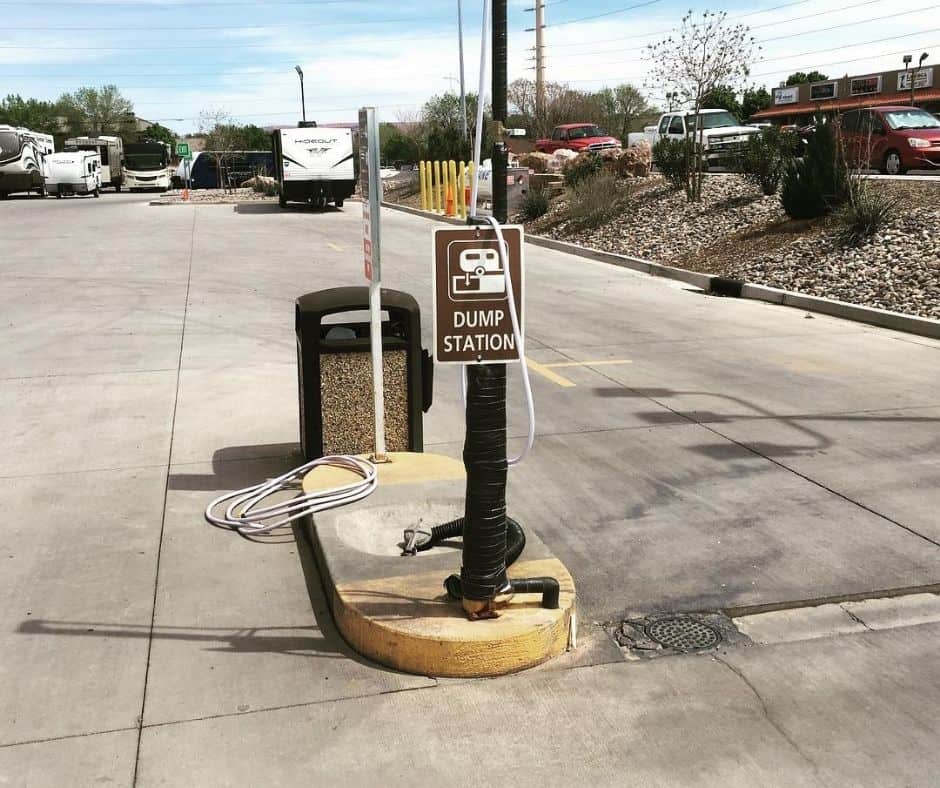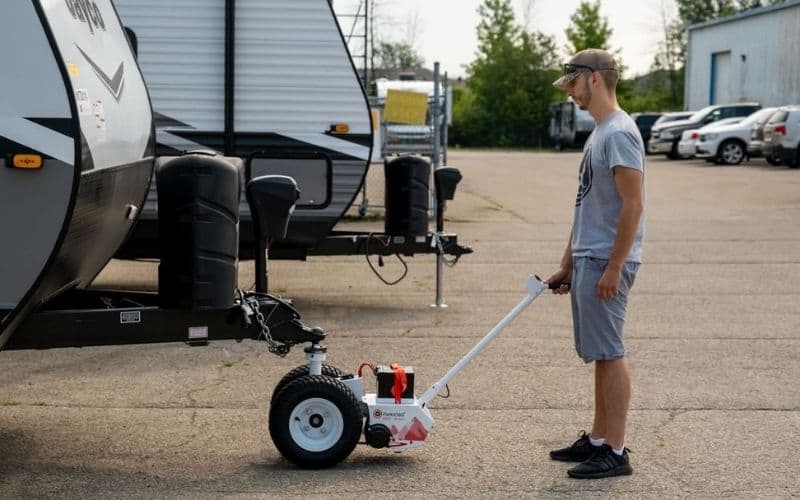One of the things that makes RVs so appealing is the ability to take the comforts of home with you while answering the call of the open road.
So, having an onboard bathroom and shower in your can enhance your travel experiences more than you may think.
When it comes to taking a shower in an RV, the experience is usually less than desirable. RV showers are typically small and have limited hot water supply or reduced pressure compared with standard plumbing fixtures at home.
Though it can be frustrating to be limited to taking short showers when you’d love to have a long soak while you are camping.
To better understand the RV bathing conundrum, we decided to take a closer look at the nuts and bolts details of RV showers to help you get the most out of them.
This includes asking and answering some important questions on taking a shower in an RV.
Do RVs Have Showers?

Unless it’s a small Class B camper van or tiny teardrop trailer, most modest size RVs includes travel trailers, fifth-wheels, and most motorhomes do have some type of bathroom and shower.
These RVs tend to have enough size and structure to accommodate a bathroom, shower, and water storage tanks to support them.
Though some smaller RV’s don’t have bathrooms at all. This is largely due to a lack of interior space to accommodate a bathroom or a lack of structure to accommodate the considerable fresh and wastewater storage tanks.
Types of RVs That Have Showers?
While most most RVs come equipped with a shower, but but not all of them have a bathroom. However, the shower size and types varies depending on different types and available space it has.
What Is The Difference Between A Full RV Bathroom vs RV Wet Bath?

When it comes to RV bathrooms there are two different configurations.
A “Wet Bath” which combines the shower and the toilet in one compact water closet type of bathroom.
A so-called “Dry Bath” or “Full Bathroom” separates the toilet and shower with a shower curtain or a glass shower door.
How Do RV Showers Work?
An RV shower relies on a supply of water from either a built-in fresh water storage tank or a direct connection to another water source such as a municipal hook up or a connection to an RV park’s fresh water system.
If you are getting water from an outside pressurized source You will need to install a pressure adapter in the hose line when you use a hookup to the RV park’s source.
This helps prevent excess pressure from potentially damaging your RV plumbing or bathroom fixtures. It does this by partially opening the valve to the water connection.
This prevents excessive pressure buildup while also helping to keep the hose firmly in place.
When you turn on the shower fixture a small internal water pump sends water from the water source, such as the fresh water storage tank to the showerhead.
The water then passes over your body and down the RV shower drain.
Where Does Shower Water Go in an RV?

Once the water goes down the drain most RV’s divert that water to a gray water storage tank.
This is a special tank that holds all the water from sinks and showers in the RV.
Some RVs don’t have a gray water storage tank, and instead, just have one large black water storage tank.
This is a single tank that holds water from the sink, shower, and toilet all in one.
When the gray water or black water storage tanks get near the limit, you need to empty the storage tank at a rate RV dump station.
If you don’t empty the storage tanks they could start to back up into the sink or shower drain.
Some full-service RV parks and campgrounds offer sewer connections at select campsites.
This is convenient as it allows the gray water from the RV’s shower and sinks to go directly into the municipal sewer system.
Where Does An RV Get Hot Water From?
Most RVs with a shower in the bathroom and/or a built-in water tank get the hot water from a compact water heater.
It works very much like the hot water heater in your home, where a propane or an electric element heats the volume of water and diverts it to the hot water fixture on demand.
The problem is that a lot of RVs only have a 6-gallon or smaller hot water tank capacity.
As you deplete it, cold, fresh water pours into the system, the internal thermostat turns on to try to heat the new volume of water.
This translates to short showers. If you need to bathe more than one person in an hour or so, the second person often ends up with a lukewarm shower or a shower where the hot water runs out while you still have soap in your hair.
How long can you take a shower in an RV?

Most RV manufacturers recommend keeping showers short, to around 2 to 3 minutes to conserve water.
Though the duration of an RV shower is largely dependent on the size of the hot water heater’s tank, and the available fresh water supply.
Not to mention the number of people you want to shower in a given evening.
A 6-gallon hot water heater should be able to shower two to three adults for two to three minute long showers.
This is ideal for times when you are boondocking off the grid. An RV with a 10 gallon or larger hot water heater offers longer showers or the ability to shower more family members in a given evening. Though there are ways to extend the potential shower time.
Tips to Achieve Extended Hot Showers In Your RV
There are a few different ways to extend the potential shower time in an RV.
This starts with setting up a showering schedule where half the family showers in the morning and the other half showers in the evening.
This gives ample time for the hot water heater to refill and reheat to maximum capacity.
Beyond a strategic approach, there are physical upgrades and ways to tap into greater resources that are worth considering.
1: Install A Water-Saving RV Showerhead

Water-saving showerheads will work in an RV bathroom the same way that they work in your home bathroom.
Though they do carry the same annoying low flow that makes them unpopular with some people.
2: Turn Off The Water When Shampooing
If you have a lot of hair, then you might spend a lot of precious minutes scrubbing in shampoo, while water simply pours down the drain.
Turning off the water while you rub the shampoo into your hair will help save rinse water.
You could double down on this strategy to use a two-in-one shampoo and conditioner combo to save even more valuable washing minutes.
3: Upgrade To A Larger Hot Water Heater
If your RV has room under the cabinet or somewhere in the plumbing infrastructure to upgrade to a larger water heater, it can give you more total gallons of water.
This can allow for longer showers or the ability to shower more people in a given evening.
4: Install A Second Hot Water Heater
If you have room under a cabinet, it might be possible to install another small water heater in parallel.
Not only will this give you more hot water per session, but it will also help refill each water heater tank faster per cycle.
5: Install A Tankless Water Heater
Tankless water heaters are a relatively new innovation that has expanded into the realm of RV water heating.
Just like the residential versions they use either propane or electricity to rapidly heat water on demand.
This gives you much more volume for longer showers, while also eliminating the need for a water heater.
You can then remove the old tank to gain more storage space in your RV’s kitchen or bathroom.
Alternatives To Showering In Your RV

There are a few alternatives to showering in your actual RV’s bathroom.
You can use these to replace a shower when you are boondocking or just to stretch out your hot water supply to let one person take a long hot shower.
These tips might also come in handy if you want to run your RV dishwasher at night, but still, need to wash the day off you.
Here are the five best alternatives to stay clean and fresh even without a sa full bathroom in your RV.
1: Use The RV Park Or Campground Shower
Some RV parks, campgrounds, and seasonal resorts also offer shower houses. Some are free or included in your rental fee.
Some are available for $2 to $5 or might be paired with laundromat access. Most of these showers are connected to large 40-gallon water heaters for longer showers.
3: Use A Solar Shower
Solar showers or Scottish showers use a large black canvas water bladder that is hung in a sunny location. As the sun beams on it through the day it warms the water up.
You can even add a gallon of water boiled on the RV stove to heat it right before showering. Then wrap a privacy shower around it for a refreshing outdoor shower.
3: Take Cold Showers
The Classic “Navy Shower” is also a viable concept. This is another “Fast” shower, where you just turn on the cold tap in the shower to wash the day off you.
It’s a desperation move for times when you want to save the hot water for your significant other or you need to run a large load in the dishwasher.
Conclusion
There are a few things you can do to maximize your RV showering time.
This starts with simple things like installing a low-flow showerhead and then turning the water off while you scrub in a two-in-one shampoo and conditioner.
If you have the space in your RV’s plumbing and the available budget, you can install a parallel water heater or upgrade to a water heater with a larger tank.
In the same vein, a tankless water heater can give you hot water on demand, while also saving space.


![4 Best A-Frame Campers with Bathrooms in [currentyear] 8 Best A-Frame Campers With Bathrooms(1)](https://www.rvingknowhow.com/wp-content/uploads/2021/11/Best-A-Frame-Campers-With-Bathrooms1-150x150.jpg)


![6 Best DIY Teardrop Trailer Kits in [currentyear]: Top Rated Teardrop Camper Kits 11 The 6 Best Teardrop Trailer Kits](https://www.rvingknowhow.com/wp-content/uploads/2021/09/The-6-Best-Teardrop-Trailer-Kits.jpg)

1 Comment
Tactrix
9 months agoThe thing that this article didn’t mention that is much more important to know is that you can make your own “recirculating shower”. The way it works is you modify your shower plumbing into a loop to where the water circles through your shower and when it goes down the drain it instead loops back around into the showerhead but not before going through 3 different filters to clean it up. It doesn’t come standard, it’s a modification, but it’s one that I think RV companies should seriously consider including as it is a huge luxury and makes showering infinitely better.